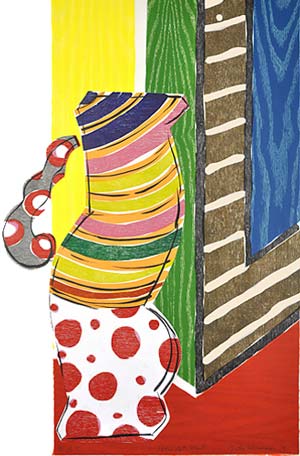
“Polka Dot Skirt” by Betty Woodman
So just what does this mean?
Well, chine-collé is a special printmaking technique in which paper of a different color or texture is adhered to the overall piece.
The paper, usually in pre-cut shapes, is actually bonded to the heavier support paper of the print in the printmaking process. It is not just glued to the print as a collage element. Chine-collé is sometimes mistakenly used to refer to any type of collage.
But, the over-all effect of collé is that the paper is actually bonded, not just glued, to the print. It can, at times, look like it is embossed.
Chine-collé roughly translates from French as “chine”= tissue, and “collé” = glue or paste. The word chine is used because the thin paper traditionally used was imported to Europe from China, India and Japan.
The Chine-Collé Process
There are many methods for creating chine-collé.
One of the commonly used includes dampening the thin paper, placing it on the inked plate. The key here – and this is what makes collé different from collage – is that it is then run through a printing press where the pressure of the press adheres and bonds the collé paper to the print.
Many of the artists we represent in the gallery use this very special technique.
None uses it more effectively than Mark Lunning. His beautiful etchings are full of chine-collé elements, often with ink printing over the actual collé. Betty Woodman is another one of our gallery artists whose use of chine-collé gives her woodcuts a 3-dimensional appearance.
This is especially noticeable in her recent woodcut print, “Polka Dot Skirt”.
Well, that’s as descriptive as we can be. Chine-collé is really something that needs to be seen, not read about. Please stop by our art gallery at in Boulder, Colorado.
We’d love to show you some beautiful examples of this special printmaking technique.
